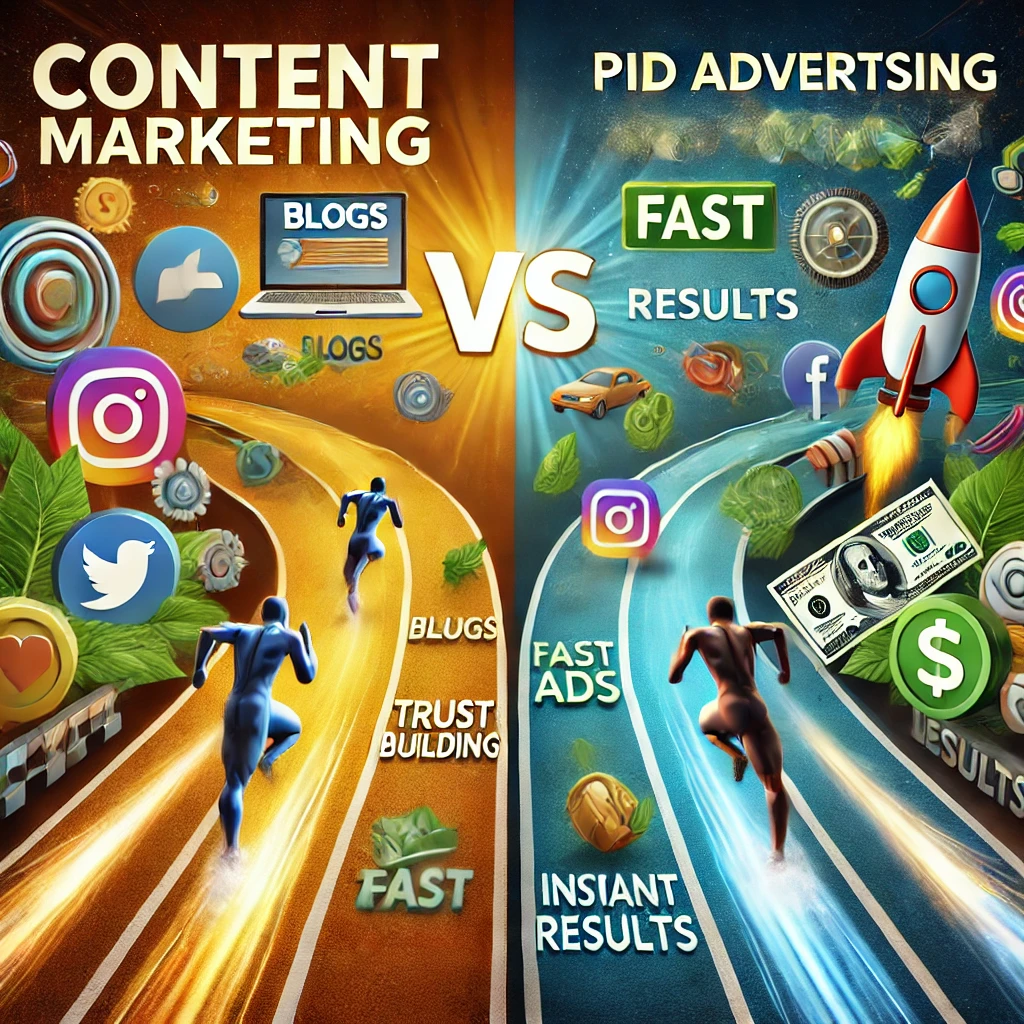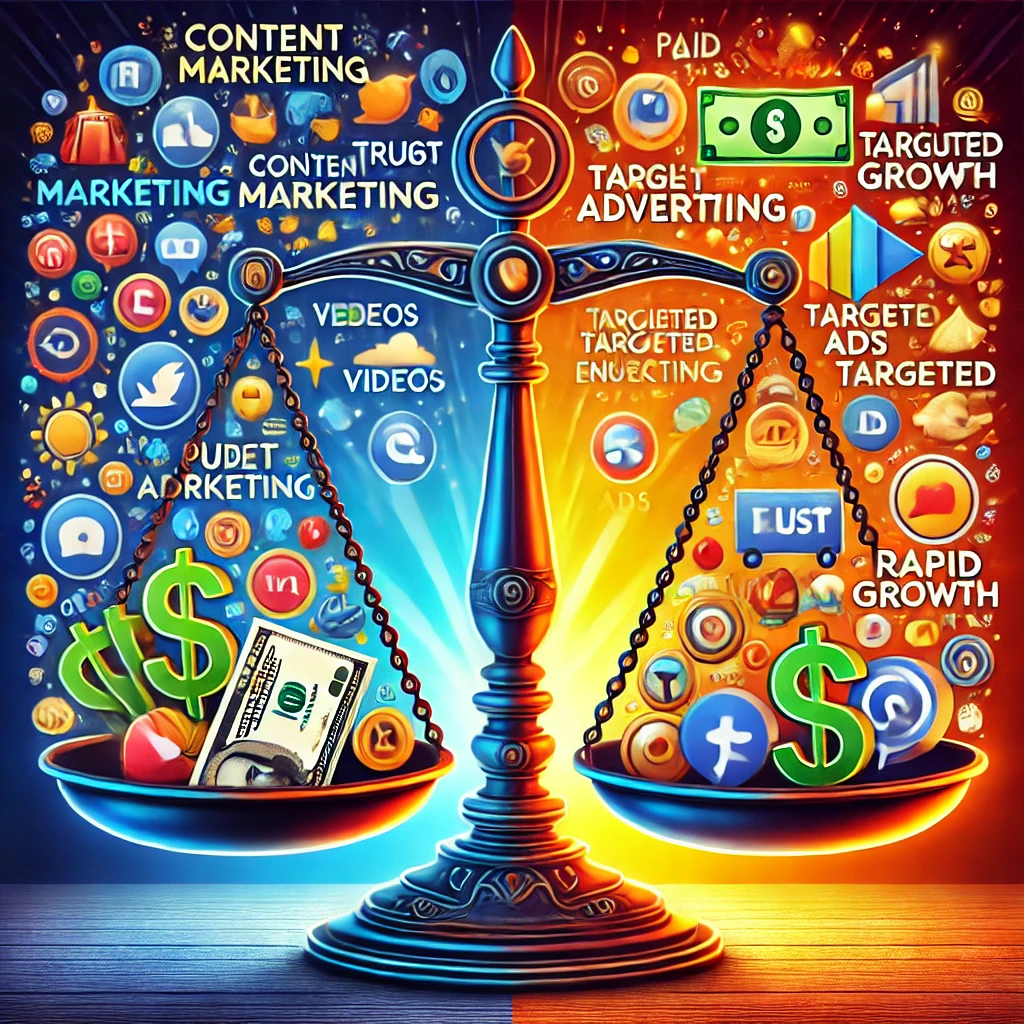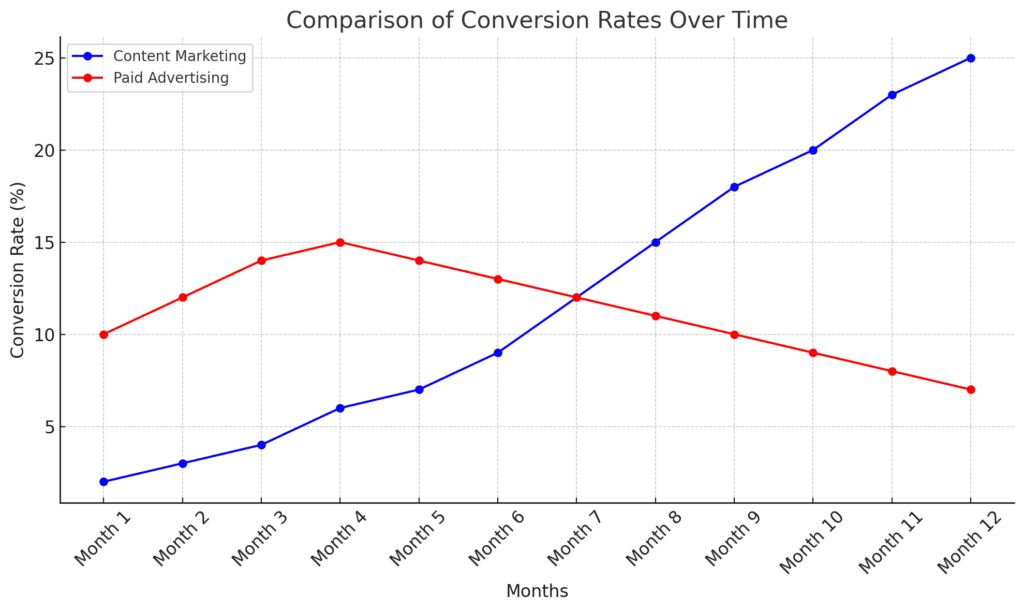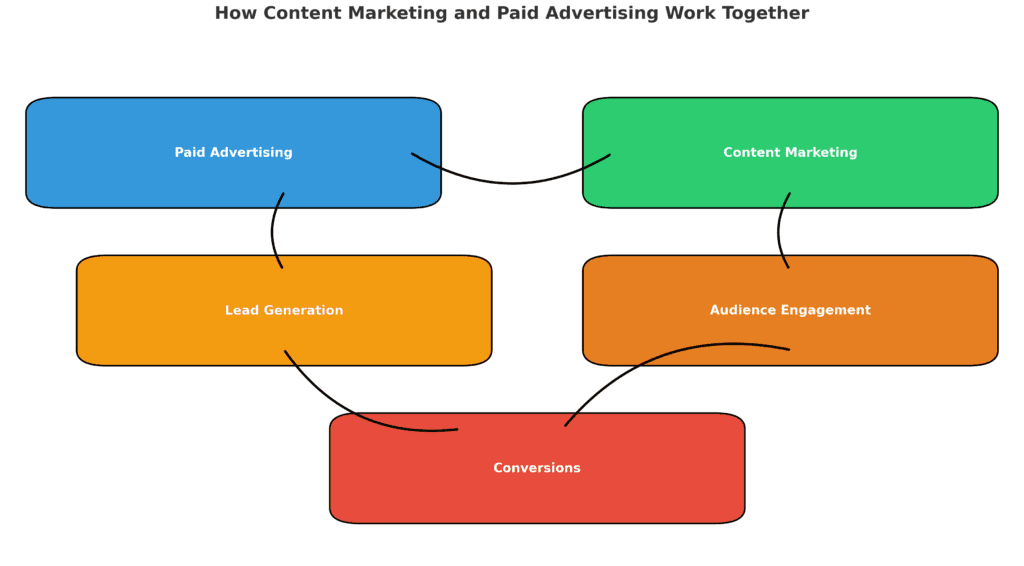
In today’s digital landscape, businesses face a pivotal decision: should they invest in content marketing or paid advertising? Both strategies offer unique advantages and can significantly impact a company’s growth and visibility. However, understanding the nuances, benefits, and potential drawbacks of each approach is essential for developing an effective marketing strategy that aligns with your business objectives. This article provides an in-depth analysis of content marketing and paid advertising, offering insights, comparisons, and real-world examples to help you make an informed decision.
Understanding Content Marketing
Content marketing involves creating and distributing valuable, relevant, and consistent content to attract and engage a clearly defined audience. The primary goal is to build trust, establish authority, and ultimately drive profitable customer actions. Content marketing works by educating and nurturing potential customers until they are ready to make a purchase.
Key Components of Content Marketing:
- Blog Posts: Regularly updated articles that provide insights, tips, and information relevant to your industry. Blog posts are the foundation of content marketing and serve to address the pain points of your audience.
- E-books and Whitepapers: In-depth resources that offer comprehensive information on specific topics. These are often used as lead magnets to collect email addresses and generate leads.
- Infographics: Visual representations of data and information to simplify complex concepts. Infographics are highly shareable and can increase brand visibility.
- Videos and Webinars: Engaging multimedia content that educates and informs your audience. Videos are an effective way to convey information in an easily digestible format, while webinars allow for direct interaction with potential customers.
- Case Studies: Real-life examples showcasing how your product or service solved a problem for a client. Case studies help build credibility and demonstrate the effectiveness of your offerings.
Pros of Content Marketing:
- Long-Term Results: Content remains accessible online, continuing to attract traffic over time, making it a valuable long-term investment. A well-written blog post or video can continue to generate leads months or even years after it was first published.
- Builds Authority: Establishes your brand as a thought leader in your industry, helping to gain the trust of your audience. By consistently providing valuable information, your brand becomes a go-to resource for your niche.
- Cost-Effective: While it requires time and effort, it often costs less than paid advertising in the long run. Content marketing may have a lower upfront cost compared to PPC campaigns, and its benefits compound over time.
- Improves SEO: Quality content helps improve your website’s search engine rankings, making it easier for potential customers to find you. By optimizing your content for relevant keywords, you can drive organic traffic to your site.
- Engages Audience: Content marketing fosters deeper engagement by providing useful information that resonates with your target audience. Interactive content like quizzes, surveys, and downloadable resources can increase audience participation.
Cons of Content Marketing:
- Time-Consuming: Requires consistent effort and patience to see significant results. Creating high-quality content takes time and may not yield immediate returns, particularly for new businesses without an established audience.
- Measurement Challenges: Tracking ROI can be complex due to the indirect nature of its benefits, such as brand awareness and trust-building. Content marketing metrics like brand sentiment and social shares can be harder to quantify compared to direct sales metrics.
- Expertise Needed: Successful content marketing requires expertise in content creation, SEO, graphic design, and storytelling. Without skilled resources, the content may not effectively engage or convert the audience.

Understanding Paid Advertising
Paid advertising involves paying for ad placements to promote your products or services. This can include pay-per-click (PPC) ads, display ads, social media ads, and more. Paid advertising is a great way to quickly generate visibility and drive targeted traffic to your website.
Key Components of Paid Advertising:
- Search Engine Ads: Ads that appear on search engine results pages (e.g., Google Ads). These ads target specific keywords that potential customers are searching for, putting your business at the top of search results.
- Social Media Ads: Promotions on platforms like Facebook, Instagram, LinkedIn, and Twitter that target users based on demographics, interests, and behaviors. Social media ads are great for building brand awareness and generating leads.
- Display Ads: Banner ads on websites within a display network that help raise brand awareness. These ads can be used for remarketing to users who have visited your site.
- Retargeting Ads: Ads targeting users who have previously interacted with your website or content, encouraging them to return and convert. Retargeting is highly effective for increasing conversions by reminding prospects about your brand.
- Native Ads: Ads that match the look, feel, and function of the media format in which they appear. These ads are designed to be less intrusive and blend seamlessly with the content, improving user experience.
Pros of Paid Advertising:
- Immediate Results: Quickly drives traffic and potential leads to your site, allowing you to see instant results from your campaigns. Paid ads can be particularly effective for product launches and time-sensitive promotions.
- Targeted Reach: Allows precise targeting based on demographics, interests, behaviors, and even location. This precision ensures that your ads are shown to people who are most likely to be interested in your products or services.
- Scalable: Budgets can be adjusted to scale campaigns up or down as needed, providing flexibility for businesses of all sizes. You can easily increase your ad spend to reach a larger audience or reduce it to save costs.
- Detailed Analytics: Provides clear metrics such as impressions, clicks, conversions, and cost-per-click (CPC), making it easy to measure campaign performance and optimize accordingly.
Cons of Paid Advertising:
- Costly: Can become expensive, especially in competitive industries where the cost-per-click (CPC) is high. Without proper management, paid advertising campaigns can quickly deplete budgets without delivering the desired results.
- Short-Term Impact: Traffic and leads may decline once the ad spend stops, making it less sustainable in the long run compared to content marketing. The effects of paid advertising are often temporary unless ongoing investment is made.
- Ad Fatigue: Audiences may become desensitized to ads over time, leading to lower click-through rates and conversions. To combat ad fatigue, creatives need to be refreshed frequently, adding to the cost.
Comparative Analysis: Content Marketing vs. Paid Advertising
To determine which strategy suits your business, consider the following factors:
1. Budget
- Content Marketing: Generally requires a lower financial investment but demands time and resources for content creation. The cost involves hiring content creators, SEO experts, and graphic designers. For small businesses, content marketing can be a cost-effective way to build an audience over time.
- Paid Advertising: Requires a direct financial investment; costs can escalate based on competition and desired reach. The more competitive your industry, the higher the cost per click or impression. Paid advertising is suitable for businesses that need rapid results and have the budget to support continuous campaigns.
2. Timeframe for Results
- Content Marketing: Yields gradual results; content builds value over time, leading to consistent and long-term organic traffic growth. It may take several months to see significant results, but the payoff is a steady stream of qualified leads.
- Paid Advertising: Delivers immediate visibility and traffic; effects diminish once spending ceases, making it a good choice for short-term campaigns. Paid ads can generate a quick influx of leads, making them ideal for promotions or testing new products.
3. Longevity
- Content Marketing: Offers enduring value; quality content can attract traffic for years and continue to generate leads without additional spending. Evergreen content can provide continuous value and help build a loyal audience.
- Paid Advertising: Provides short-term gains; requires ongoing investment to maintain visibility. Once the budget is exhausted, the ads stop running, and the visibility ends, unlike content that continues to exist online.
4. Audience Trust
- Content Marketing: Builds trust through valuable information and thought leadership. By providing helpful content, you establish a relationship with your audience, making them more likely to trust your brand. This trust can lead to long-term customer loyalty and repeat business.
- Paid Advertising: May be perceived as intrusive; trust depends on ad relevance and presentation. Ads that are well-targeted and relevant can still be effective in building a connection with the audience. However, ads that are poorly targeted may lead to a negative perception of your brand.
5. Measurability
- Content Marketing: Challenging to measure direct ROI; success often gauged through engagement metrics like shares, comments, and time spent on page. Tools like Google Analytics can help track traffic and conversion goals, but the impact of content is often cumulative and indirect.
- Paid Advertising: Offers clear metrics; platforms provide detailed analytics on performance, including impressions, clicks, conversions, and cost-per-click (CPC). The ability to measure performance in real-time allows for quick adjustments to improve results.
Comparison of Content Marketing and Paid Advertising
| Factor | Content Marketing | Paid Advertising |
|---|---|---|
| Budget | Lower financial cost; higher time investment | Higher financial cost; scalable spending |
| Timeframe | Long-term results; gradual growth | Immediate results; short-term impact |
| Longevity | Content remains valuable over time | Visibility ends when spending stops |
| Audience Trust | Builds trust through valuable content | Depends on ad relevance and user perception |
| Measurability | Indirect ROI; measured through engagement | Direct ROI; detailed performance analytics available |
Research Insights: Effectiveness of Content Marketing vs. Paid Advertising
A research paper published by the Content Marketing Institute (CMI) reveals that 72% of marketers believe that content marketing leads to increased engagement and brand loyalty over time. On the other hand, a study by HubSpot suggests that paid advertising is effective for generating immediate leads, but maintaining customer loyalty requires consistent value delivery through content.

Here is the chart comparing the conversion rates of content marketing and paid advertising over a 12-month period. The chart shows that while paid advertising provides a higher conversion rate initially, content marketing gradually surpasses it as time goes on, indicating sustained growth.
How Content Marketing and Paid Advertising Work Together
The diagram below shows how content marketing and paid advertising can complement each other effectively.
- Paid Ads Drive Initial Traffic: Paid advertising is used to promote high-quality content, increasing reach and driving initial traffic to your website.
- Content Nurtures Leads: Once the audience engages with your content, they are nurtured through valuable information, building trust and moving them closer to conversion.
- Remarketing and Retargeting: Retarget users who have engaged with your content using tailored ads to encourage conversions.

Highly Searched Questions About Content Marketing vs. Paid Advertising
To help you make an informed decision, here are some of the most frequently asked questions about content marketing and paid advertising:
1. Which is more cost-effective: content marketing or paid advertising?
Content marketing is generally more cost-effective in the long run. While it requires a significant time investment, the content continues to generate organic traffic without additional spending. Paid advertising, on the other hand, requires continuous investment to maintain visibility.
2. How long does it take to see results from content marketing?
Content marketing is a long-term strategy, and it can take several months to start seeing significant results. The timeframe depends on the quality of the content, consistency, and SEO efforts.
3. Can I use both content marketing and paid advertising together?
Absolutely! Integrating both strategies can maximize your marketing efforts. For example, you can use paid ads to promote valuable content and drive initial traffic, while content marketing helps build trust and long-term engagement.
4. Which strategy is better for building brand authority?
Content marketing is more effective for building brand authority. By consistently providing valuable content, you establish yourself as an industry expert, which helps build trust with your audience.
5. What are the risks of relying solely on paid advertising?
Relying solely on paid advertising can be risky because it requires ongoing investment. Once the budget runs out, the visibility of your ads stops, leading to a potential drop in traffic and leads. Additionally, ad fatigue can reduce the effectiveness of paid campaigns over time.
6. How can I measure the success of content marketing?
The success of content marketing can be measured using metrics such as website traffic, engagement (likes, shares, comments), time spent on page, lead generation, and organic search rankings. Google Analytics and other tools can help track the performance of your content.
7. Is content marketing better for SEO than paid advertising?
Yes, content marketing is generally better for SEO than paid advertising because it helps build organic traffic over time. By optimizing content with relevant keywords and providing value, you can improve search engine rankings, making it easier for potential customers to find your website.
8. What types of content work best for content marketing?
The types of content that work best for content marketing include blog posts, infographics, videos, case studies, e-books, and social media content. The key is to provide valuable, informative, and engaging content that addresses your audience’s needs and interests.
9. How does ad fatigue impact paid advertising?
Ad fatigue occurs when your target audience becomes tired of seeing the same ads repeatedly, leading to lower engagement and conversion rates. To avoid ad fatigue, it is essential to refresh your creatives regularly, rotate different ads, and personalize the content to keep your audience interested.
10. How do I decide the right balance between content marketing and paid advertising?
The right balance between content marketing and paid advertising depends on your business goals, budget, and audience. For long-term growth and brand building, content marketing is ideal. For quick results and targeted reach, paid advertising is the way to go. Many businesses benefit from integrating both strategies to amplify their overall marketing efforts.
Conclusion
Choosing between content marketing and paid advertising depends on your business goals, budget, and desired timeframe for results. Content marketing offers sustainable growth and builds brand authority, while paid advertising provides quick visibility and targeted reach. A balanced approach, integrating both strategies, can maximize your marketing efforts and drive long-term success.
Content marketing works best for businesses looking to build long-term relationships and provide ongoing value, while paid advertising is ideal for generating quick wins and targeting specific audiences with precision. The integration of both approaches can amplify your reach, engage your audience, and drive conversions.
Key Takeaways
| Aspect | Content Marketing | Paid Advertising |
| Cost | Lower cost over time | Higher upfront cost |
| Time to Results | Slower but sustainable | Immediate but temporary |
| Audience Engagement | High engagement through valuable content | Engagement depends on ad quality |
| Trust Building | Builds authority and trust | Trust depends on ad relevance |
| Best Use Case | Brand building, long-term growth | Short-term promotions, rapid visibility |
If you’re ready to take your business to the next level, consider leveraging both content marketing and paid advertising to boost your online presence. Contact us today to learn how we can help you create a customized marketing strategy that delivers results. Contact Us to get personalized assistance.
For more information on government guidelines and support for digital marketing initiatives, visit the official Government of India Digital India Program website.


